Officially known as the Arab Republic of Egypt, the modern country of Egypt came into existence in 1922. Ancient Egypt was one of the first significant civilizations on the planet with roots going back to around 3200 BCE. Egypt’s landmass is twice the size of California. This means that it shares its borders with a handful of other countries. We’ll discover the 4 countries that border Egypt now.
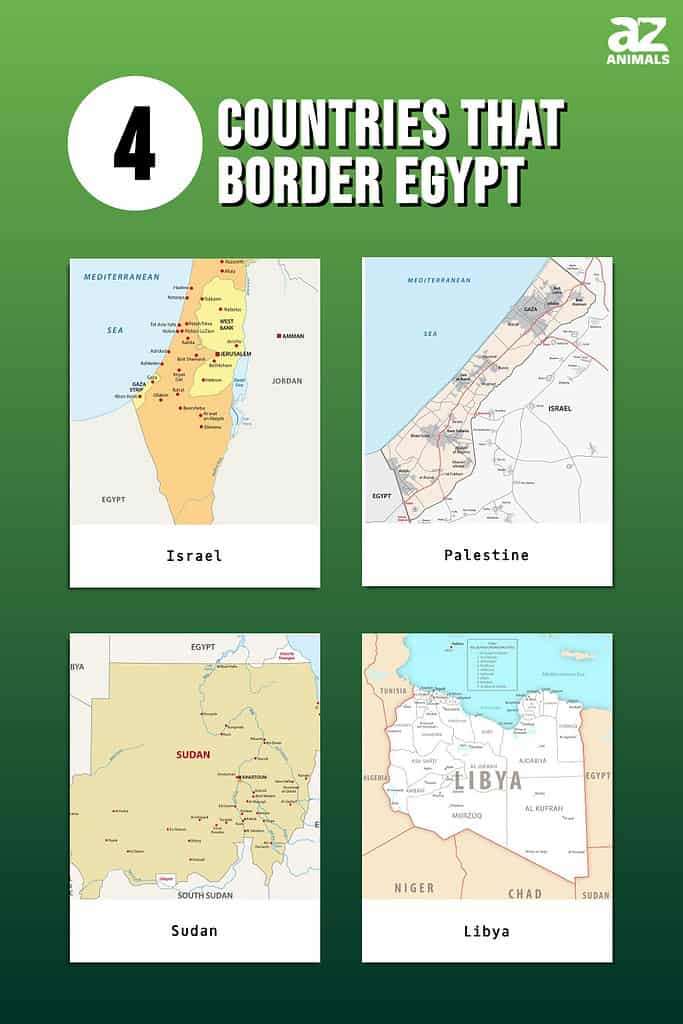
Where is Egypt?
The Arab Republic of Egypt is mostly in northeast Africa and is bordered by Israel, Palestine’s Gaza Strip, Sudan, and Libya. Most of Egypt is in North Africa with its eastern Sinai Peninsula lying in the Middle East. The Middle East is part of West Asia.
Egypt is considered part of the Arabic world, and it’s the most populated Arab country on the planet. It has the third largest population in Africa behind Ethiopia and Nigeria.
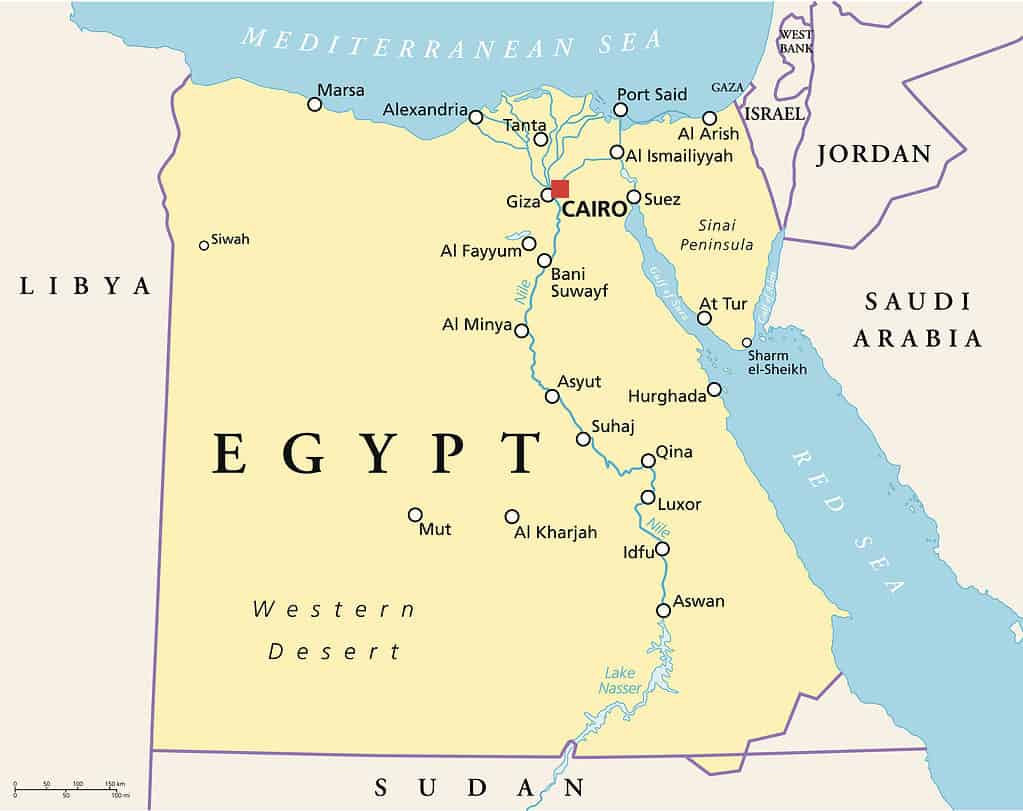
Egypt is bordered by Israel, Palestine’s Gaza Strip, Sudan, and Libya.
©iStock.com/PeterHermesFurian
A little over 100 million people are residents, and 20 million Egyptians live in the capital city of Cairo. Over 85 percent of its residents are Sunni Muslims.
The Nile River and its delta are the nexus of Egyptian civilization with few population centers existing outside of its geographical reach. 95 percent of the nation’s population lives within a handful of miles of the Nile. The rest of the country, except for the coasts of two gulfs, the Red Sea, and the Mediterranean, is made up of open desert.
Lake Nasser crosses the Tropic of Cancer in the southern part of Egypt. The lake dips across the border into northern Sudan, and it is created by the Aswan High Dam that impounds the Nile. This body of water is almost 300 miles long, and it’s just under 10 miles across at its widest spot.
1. Egypt’s Eastern Border: Israel

Israel borders Egypt’s Sinai Peninsula.
©Rainer Lesniewski/ via Getty Images
The State of Israel is situated in West Asia, and this small country shares its southwest border with Egypt. The technological and economic center of the country is the city of Tel Aviv.
Internally, Jerusalem is the capital of the country. The international community recognizes East Jerusalem as part of Palestine’s West Bank. In the past, ownership of Egypt’s Sinai Peninsula was in question.
Egypt and Israel now have an established peace treaty. This means that the Sinai Peninsula is a part of the Arab Republic of Egypt. Israel’s withdrawal occurred in the early 1980s in exchange for Egypt’s recognition of Israeli sovereignty.
A large portion of the Holy Land in Abrahamic religions is within Israel. The Dome of the Rock, the Western Wall, the Al-Aqsa Mosque, the Church of the Annunciation, and the Tower of David are some of the historic sights within the country.
2. Smallest Territory Bordering Egypt: Palestine
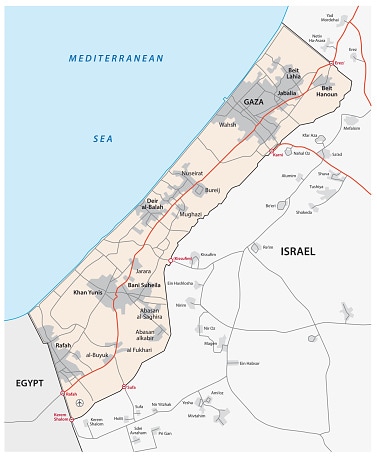
Palestine’s Gaza Strip is on Egypt’s eastern border.
©Rainer Lesniewski/ via Getty Images
The State of Palestine in West Asia is under Israeli occupation, and this political situation is a hot-button topic in the region and internationally. Palestine is a member of the Arab League which recognizes it as a United Nations non-member observer state.
As of November 15, 1988, Egypt recognizes and supports Palestine’s independence. Palestine’s Gaza Strip borders Egypt to its northeast along the Sinai Peninsula. Additionally, the West Bank north of Jerusalem is also Palestinian territory.
Due to the tumultuous politics in Palestine, animal welfare sometimes doesn’t receive the attention it deserves. As a consequence, it’s very difficult to enforce animal conservation policies. This results in the sale of illegal animals at markets. This is a result of a lack of propagated information about species needing protection within the general population.
As a result of a study conducted between 2013 and 2020, it was discovered that 79 vertebrates that shouldn’t be traded were found in markets in the West Bank. Some of the affected species include mountain gazelles (Gazella gazella), Greek tortoises (Testudo graeca), striped hyenas (Hyaena hyaena), and European turtle doves (Spreptopelia turtur). The establishment of wildlife centers within Palestine, and efforts by local conservationists, are actively addressing these issues.
3. Sudan: Egypt’s Southern Border
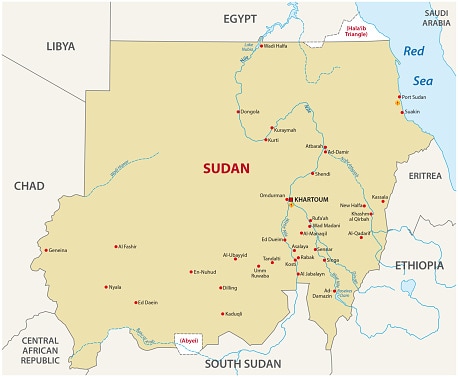
Sudan is south of Egypt.
©Rainer Lesniewski/ via Getty Images
The Republic of the Sudan lies on Egypt’s southern border. A little over 45 million people are living in the country, with 30 million of those people belonging to Nubian tribes.
It’s important to note that there have been permanent settlers in Sudan since approximately 8000 BCE. As a result of Sudan’s proximity to Egypt, this means that the country contains more Ancient Egyptian pyramids than modern Egypt.
Despite this rich history, Sudan is one of the poorest countries in the world because 95 percent of the population lives on less than 3 and a half American dollars per day. Over 19 million people, who make up about 40 percent of the country, are experiencing food insecurity.
Political conflicts currently plague modern Sudan. This has resulted in the suspension of the United Nations’ World Food Program after the deaths of 3 aid workers in April 2023.
Importantly, the Nile River flows through Sudan on its way north into Egypt. This means that the southern part of Lake Nasser creeps over Sudan’s northern border. Seventeen percent of Lake Nasser is in Sudan.
The majority of the lake is in Egypt. However, the Sudanese call their section on their side of the border Lake Nubia. This is a result of the displacement of the Nubians who lived in southern Egypt and northern Sudan.
The Nubians are the descendants of the first people that inhabited the Central Nile Valley. This means that they are directly related to people who originated from one of the original cradles of civilization.
4. Western Border of Egypt: Libya
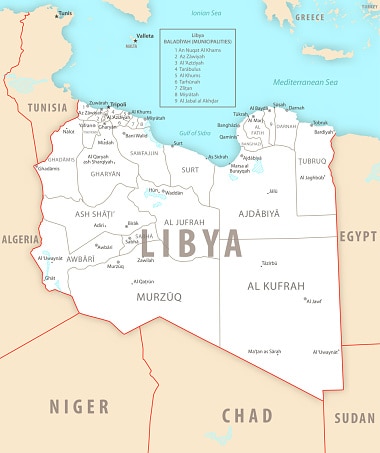
Libya is on Egypt’s western border.
©Nataliia Nikolenko/ via Getty Images
The State of Libya is in North Africa and it shares its eastern border with Egypt. Around 97 percent of its population are Sunni Muslims, and its official language is Arabic.
The land comprising Libya has hosted sedentary human occupation since at least 8000 BCE. Libya experienced Italian colonial occupation, however, it declared independence as the United Kingdom of Libya in 1951. Since then, two civil wars have occurred, and as a result, unrest continues within the country.
Oversight on food is lacking in Libya. This means that meat in cities like Benghazi is subject to bacterial contamination. In a study released in 2019, sixty percent of the mutton for sale violated the maximum amount of bacteria allowed for public safety reasons. Causing this is a lack of enforcement of sanitation in slaughterhouses and butcher shops.
| Countries Bordering Egypt | Population | Year Independence Established |
|---|---|---|
| Egypt | 109.3 Million People | 1953 |
| Israel | 9.4 Million People | 1948 |
| Palestine (Gaza Strip and West Bank) | 4.92 Million People | Contested |
| Sudan | 45.7 Million People | 1956 |
| Libya | 6.74 Million People | 1951 |
The photo featured at the top of this post is © AlexAnton/Shutterstock.com
Thank you for reading! Have some feedback for us? Contact the AZ Animals editorial team.






